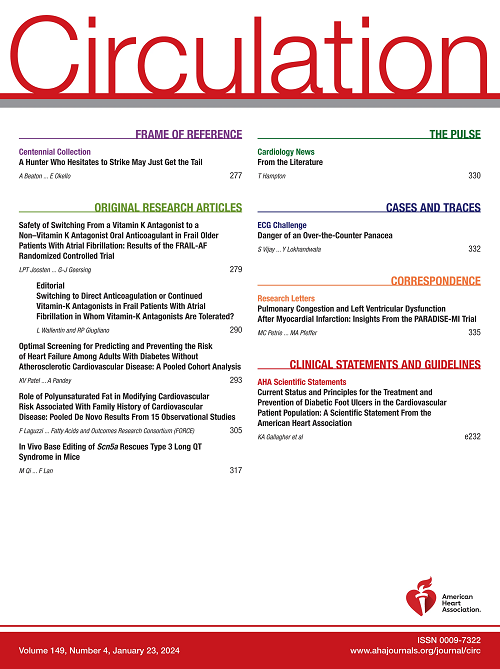Suppression of the Prostaglandin I2-Type 1 Interferon Axis Induces Extramedullary Hematopoiesis to Promote Cardiac Repair After Myocardial Infarction.
IF 35.5
1区 医学
Q1 CARDIAC & CARDIOVASCULAR SYSTEMS
引用次数: 0
Abstract
BACKGROUND Immune cells are closely associated with all processes of cardiac repair after myocardial infarction (MI), including the initiation, development, and resolution of inflammation. Spleen extramedullary hematopoiesis (EMH) serves as a crucial source of emergency mature blood cells that are generated through the self-renewal and differentiation of hematopoietic stem/progenitor cells (HSPCs). However, how EMH responds to MI and the role of EMH in cardiac repair after MI remains unclear. METHODS To assess the role of spleen EMH in MI, a Tcf21CreER Scfflox/flox MI mouse model with inhibited EMH was constructed. GFP+ (green fluorescent protein) hematopoietic stem cells were sorted from eGFP (enhanced green fluorescent protein) mouse spleen by flow cytometry and injected into Tcf21CreER Scfflox/flox mice to test the sources of local inflammatory cells during MI. Using highly specific liquid chromatography-tandem mass spectrometry and single-cell RNA sequencing, we analyzed the lipidomic profile of arachidonic acid metabolites and the transcriptomes of HSPCs in the spleen after MI. RESULTS We found that MI enhanced EMH, as reflected by the increase in spleen weight and volume and the number of HSPCs in the spleen. The lack of EMH in Scf-deficient mice exacerbated tissue injury after MI. Analysis of the transcriptome of spleen HSPCs after MI revealed that the type 1 interferon pathway was substantially inhibited in hematopoietic stem cell/multipotent progenitor subclusters, and the absence of type 1 interferon signaling enhanced the MI-induced spleen EMH. Lipidomics analysis revealed that prostaglandin I2 (PGI2) was markedly reduced in the spleen. PGI2 suppressed MI-induced EMH through a PGI2 receptor (IP)-cyclic adenosine monophosphate-453p-SP1 cascade in spleen HSPCs. Hematopoietic cell-specific IP-deficient mice exhibited enhanced EMH and improved cardiac recovery after MI. CONCLUSIONS Together, our findings revealed that a PGI2-IFN axis was involved in spleen EMH after MI, providing new mechanistic insights into spleen EMH after MI and offering a new therapeutic target for treating ischemic cardiac injury.抑制前列腺素2- 1型干扰素轴诱导髓外造血促进心肌梗死后心脏修复
免疫细胞与心肌梗死(MI)后心脏修复的所有过程密切相关,包括炎症的发生、发展和消退。脾髓外造血(EMH)是通过造血干细胞/祖细胞(HSPCs)的自我更新和分化而产生的紧急成熟血细胞的重要来源。然而,EMH如何响应心肌梗死以及EMH在心肌梗死后心脏修复中的作用尚不清楚。方法建立EMH受到抑制的Tcf21CreER Scfflox/flox心肌梗死小鼠模型,研究脾脏EMH在心肌梗死中的作用。流式细胞术从eGFP(增强型绿色荧光蛋白)小鼠脾脏中分离出GFP+(绿色荧光蛋白)造血干细胞,注射到Tcf21CreER Scfflox/flox小鼠体内,检测心肌梗死过程中局部炎症细胞的来源。我们分析了MI后花生四烯酸代谢物的脂质组学特征和脾脏中HSPCs的转录组学特征。结果我们发现MI增强了EMH,表现为脾脏重量和体积的增加以及脾脏中HSPCs的数量。造血干细胞缺陷小鼠的EMH缺失加重了心肌梗死后的组织损伤。对心肌梗死后脾脏HSPCs的转录组分析显示,造血干细胞/多能祖细胞亚群中的1型干扰素通路被显著抑制,1型干扰素信号的缺失增强了心肌梗死诱导的脾脏EMH。脂质组学分析显示脾脏前列腺素I2 (PGI2)明显降低。PGI2通过PGI2受体(IP)-环磷酸腺苷-453p- sp1级联抑制mi诱导的EMH。结果表明,PGI2-IFN轴参与心肌梗死后脾脏EMH的调控,为心肌梗死后脾脏EMH的机制研究提供了新的思路,为缺血性心脏损伤的治疗提供了新的靶点。
本文章由计算机程序翻译,如有差异,请以英文原文为准。
求助全文
约1分钟内获得全文
求助全文
来源期刊

Circulation
医学-外周血管病
CiteScore
45.70
自引率
2.10%
发文量
1473
审稿时长
2 months
期刊介绍:
Circulation is a platform that publishes a diverse range of content related to cardiovascular health and disease. This includes original research manuscripts, review articles, and other contributions spanning observational studies, clinical trials, epidemiology, health services, outcomes studies, and advancements in basic and translational research. The journal serves as a vital resource for professionals and researchers in the field of cardiovascular health, providing a comprehensive platform for disseminating knowledge and fostering advancements in the understanding and management of cardiovascular issues.
 求助内容:
求助内容: 应助结果提醒方式:
应助结果提醒方式:


